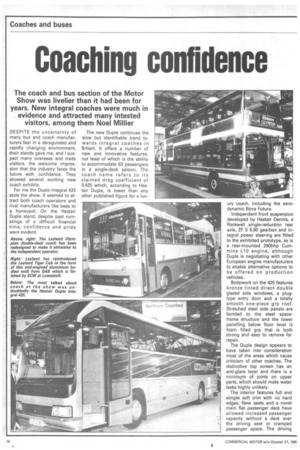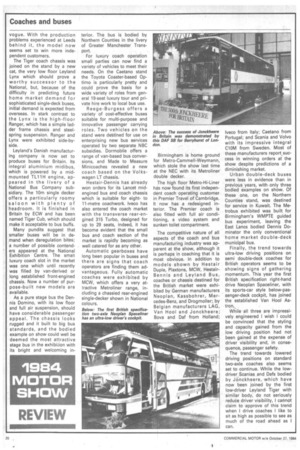Coaching confidence
Page 24

Page 25

Page 26

If you've noticed an error in this article please click here to report it so we can fix it.
The coach and bus section of the Motor Show was livelier than it had been for years. New integral coaches were much in evidence and attracted many intested visitors, among them Noel Millier
DESPITE the uncertainty of many bus and coach manufacturers fear in a deregulated and rapidly changing environment, their stands gave me, and I suspect many overseas and trade visitors, the welcome impression that the industry faces the future with confidence. They showed several exciting new coach exhibits.
For me the Duple Integral 425 stole the show. It seemed to attract both coach operators and rival manufacturers like bees to a honeypot. On the Hestair Duple stand, despite past rumblings of a difficult financial time, confidence and pride were evident. The new Duple continues the slow but identifiable trend towards integral coaches in Britain. It offers a number of new and innovative features, not least of which is the ability to accommodate 63 passengers in a single-deck saloon. The coach name refers to its claimed drag coefficient of 0.425 which, according to Hestair Duple, is lower than any other published figure for a lux ury coach, including the aerodynamic Bova Futura.
Independent front suspension developed by Hestair Dennis, a Rockwell single-reduction rear axle, ZF S 6.90 gearbox and integral power steering are fitted to the exhibited prototype, as is a rear-mounted 290bhp Cummins L10 engine, although Duple is negotiating with other European engine manufacturers to enable alternative options to be offered on production vehicles.
Bodywork on the 425 features bronze tinted direct double glazed side windows, a plugtype entry door and a totally smooth one-piece grp roof. Stretched steel side panels are bonded to the steel spaceframe structure and the lower panelling below floor level is foam filled grp that is both strong and easy to remove for repair.
The Duple design appears to have taken into consideration most of the areas which cause criticism of other coaches. The distinctive top screen has an anti-glare layer and there is a minimum of joints on upper parts, which should make water leaks highly unlikely.
The interior features full and simple soft trim with no hard edges. New seats and a novel main flat passenger deck have allowed increased passenger capacity without a deck over the driving seat or cramped passenger space. The driving position is slightly lower than the passenger deck, in keeping with current fashion, but not so low as to compromise driver safety by reducing visibility. In fact the reverse is true.
The show 425 prototype will be used in development tests and will probably never carry a passenger. The development programme is well advanced and the first production vehicles should be on the road by early next summer.
Duple says the vehicle will be easy to operate and maintain, and efficient to produce. It is also to be competitively priced at around £65,000.
Hestair Duple's latest onchassis bodies, the Caribbean 2 and Laser 2 vehicles, have been considerably restyled and improved with cleaner, more European lines. The high-floor Caribbean 2 appeared for the first time with a one-piece windscreen.
Britain's coach body market leader Plaxtons has had its troubles recently, but was able to announce an end to the long strike that has delayed production of its successful Paramount range. It also prevented there being a full display of the 1985 Paramount models, although the company was able to exhibit an updated highfloor 'Paramount 3,500 model on Volvo BlOM chassis. This vehicle featured a new and much improved soft trim interior with aircraft-style enclosed luggage rack lockers.
Two other trends discernible at the show were reflected in the Plaxtons exhibits. First, increasing numbers of doubledeck coach models are now offered. The Plaxtons Paramount 4,000 three-axle machine on NeopIan underframe was one of seven vehicles falling into this category.
Secondly, deregulation could mean an increased interest in smaller vehicles such as the third Plaxtons exhibit: a Supreme midicoach. The coach, which drew a lot of interest, had been borrowed from an operator in Barrhead, Scotland, and was based on a MercedesBenz 608D chassis.
Leyland Bus now has models to meet most likely demands and most types of operation. Its redesigned Olympian doubledecker aroused favourable comment from some operators, although others felt it had neither the long range possibilities of its three-axle competitors, nor the ability to be down graded to a stage bus in later life — its rear staircase made it unsuitable for one-person bus operation. The coach was awarded a major coachwork medal {see page 17) and is the first short-haul middle range double-deck coach to be supplied to an independent coach operator.
The other middle-range double deck coach on show appeared on the Alexander stand. The distinctive RDC body was both roomy and well appointed and, like the ECW-bodied Olympian, features full soft trim. The Alexander coach will be used on Scottish Bus Group Citylink routes. It is built on the Volvo Citybus chassis.
Three-axle 12m double-deckers have found a ready market and examples were displayed on the Kassbohrer, MCW, Jonckheere and NeapIan stands. The Jonckheere doubledeck was the first to be built using the modular Scania K112TR chassis equipped with computer aided gear-change system.
The long established Neoplan Skyliner attracted considerable interest as it was the first fitted with a British Gardner 6LYT engine driving through a fully automatic six-speed ZF gearbox.
Leyland Bus had a discouraging start with its Royal Tiger integral, but the example on show; which was built at Workington, was very well finished and still seemed well in vogue. With the production problems experienced at Leeds behind it, the model now seems set to win more independent customers.
The Tiger coach chassis was joined on the stand by a new cat, the very low floor Leyland Lynx which should prove a worthy successor to the National, but, because of the difficulty in predicting future home market demand for sophisticated single-deck buses, initial demand is expected from overseas. In stark contrast to the Lynx is the high-floor Ranger, which has a simple ladder frame chassis and steelspring suspension. Ranger and Lynx were exhibited side-byside.
Leyland's Danish manufacturing company is now set to produce buses for Britain. Its integral aluminium midibus, which is powered by a midmounted TL11H engine, appeared in the livery of a National Bus Company subsidiary. The 10m single decker offers a particularly roomy saloon with plenty of headroom. It is finished in Britain by ECW and has been named Tiger Cub, which should make it acceptable to bus buffs.
Many pundits suggest that smaller buses will be in demand when deregulation bites; a number of possible contenders appeared at the National Exhibition Centre, The small luxury coach slot in the market was one which until recently was filled by van-derived or long established front-engined chassis, Now a number of purpose-built new models are available.
As a pure stage bus the Dennis Domino, with its low floor and full air suspension, should have considerable passenger appeal. The chassis looks rugged and it built to big bus standards, and the bodied example on show could well be deemed the most attractive stage bus in the exhibiiion with its bright and welcoming in tenor. The bus is bodied by Northern Counties in the livery of Greater Manchester Transport.
For luxury coach operation small parties can now find a variety of vehicles to meet their needs. On the Caetano stand the Toyota Coaster-based Optimo is particularly pretty and could prove the basis for a wide variety of roles from general 19-seat luxury tour and private hire work to local bus use.
Reege-Burgess offers a variety of cost-effective buses suitable for multi-purpose and innovative passenger carrying roles. Two vehicles on the stand were destined for use on enterprising new bus services operated by two separate NBC subsidies. Dormobile offers a range of van-based bus conversions, and Made to Measure Minicoaches revealed a new coach based on the Volkswagen LT chassis.
Hestair-Dennis has already won orders for its Lancet midenginecl bus and coach chassis which is suitable for eightto 11-metre coachwork. lveco has also entered the coach market with the transverse rear-engined 315 Turbo, designed for up to 29 seats, indeed, it has become evident that the small bus and coach section of the market is rapidly becoming as well catered for as any other.
Automatic gearboxes have long been popular in buses and there are signs that coach operators are finding them advantageous. Fully automatic coaches were exhibited by MCW, which offers a very attractive Metroliner range, including a chassied rear-engined single-decker shown in National colours, Birmingham is home ground for Metro-Cammell-Weymann, which stole the show last time at the NEC with its Metroliner double decker.
The high floor Metro-Hi-Liner has now found its first independent coach operating customer in Premier Travel of Cambridge. It now has a redesigned interior. The Premier coach is also fitted with full air conditioning, a video system and sunken toilet compartment.
The competitive nature of all aspects of the coach and bus manufacturing industry was apparent at the show, although it is perhaps in coaching that it is most obvious. In addition to models shown by Hestair Duple, Plaxtons, MCW, HestairBennis and Leyland Bus, coaches or chassis destined for the British market were exhibited by German manufacturers Neoplan, Kassbohrer, Mercedes-Benz, and Drogmoller; by Belgian manufacturers LAG, Van Hool and Jonckheere; Bova and Daf from Holland; Iveco from Italy; Caetano from Portugal; and Scania and Volvo with its impressive integral C1OM from Sweden. Most of these manufacturers report_success in winning orders at the show despite predictions of a diminishing market.
Urban double-deck buses were less in evidence than in previous years, with only three bodied examples on show. Of these one, on the Northern Counties stand, was destined for service in Kuwait. The Metrobus exhibited was built for Birmingham's WMPTE guided bus experiment, leaving the East Lancs bodied Dennis Dominator the only conventional home market double-deck municipal bus.
Finally, the trend towards ultra-low driving positions on semi double-deck coaches for British operators seems to be showing signs of gathering momentum. This year the first British specification right-hand drive Neoplan Spaceliner, with its sports-car style below-passenger-deck cockpit, has joined the established Van Hool Astron._ While all three are impressively engineered I wish I could be convinced that the styling and capacity gained from the low driving position had not been gained at the expense of driver visibility and, in consequence, passenger safety.
The trend towards lowered driving positions on standard two-axle coaches also seems set to continue. While the lowdriver Scanias and Oafs bodied by Jonckheere, which have now been joined by the first law-driver Leyland Tiger with similar body, do not seriously reduce driver visibility, I cannot claim to approve of this trend when I drive coaches I like to sit as high as possible to see as much of the road ahead as I can.


















































































































